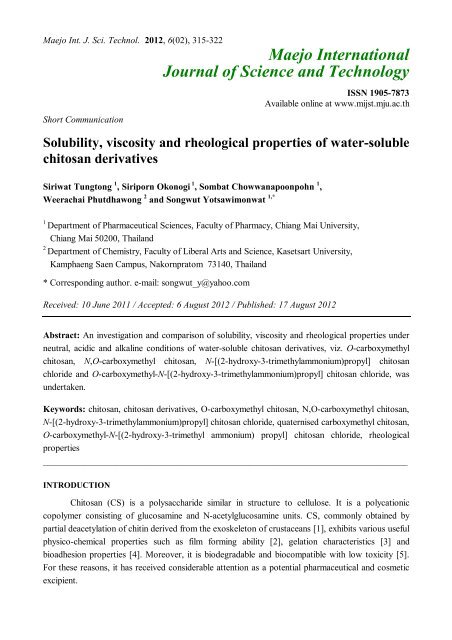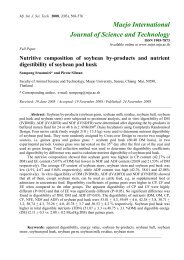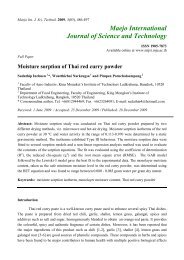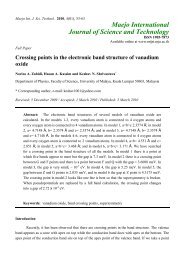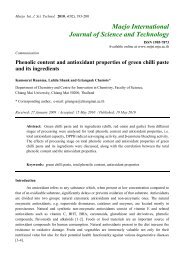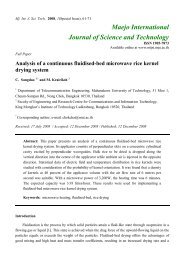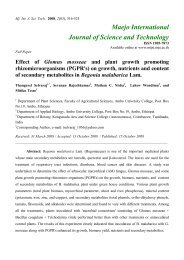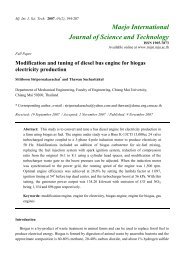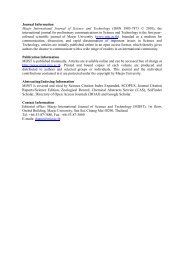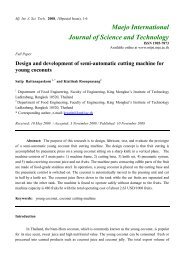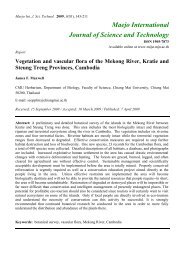Solubility, viscosity and rheological properties of water-soluble ...
Solubility, viscosity and rheological properties of water-soluble ...
Solubility, viscosity and rheological properties of water-soluble ...
Create successful ePaper yourself
Turn your PDF publications into a flip-book with our unique Google optimized e-Paper software.
Maejo Int. J. Sci. Technol. 2012, 6(02), 315-322319Viscosity <strong>and</strong> Rheological PropertyThe <strong>rheological</strong> property <strong>of</strong> a 1% (w/v) CS derivative in distilled <strong>water</strong>, 0.1N NaOH or 0.1NHCl was investigated using a Bob-<strong>and</strong>-Cup format rotational rheometer (R/S Rheometer, BrookfieldViscometer LTD., Engl<strong>and</strong>). The measuring system was CC48 <strong>and</strong> the mode used was CSR(controlled shear rate). The measurement was done in two stages: (1) during an increase <strong>of</strong> shearrate from 0 to 1,000 s -1 in 3 min., <strong>and</strong> (2) during a decrease <strong>of</strong> shear rate from 1,000 to 0 s -1 in 3 min.All measurements were performed in triplicate at a controlled temperature <strong>of</strong> 25±1ºC. The data wereanalysed with Brookfield Rheo 2000 s<strong>of</strong>tware. Apparent <strong>viscosity</strong> (Table 2), expressed in mPas, wasan average <strong>of</strong> the ratio <strong>of</strong> shear stress to shear rate calculated from both the upward <strong>and</strong> downwardcurves <strong>of</strong> the rheogram.Rheograms <strong>of</strong> the CS derivatives are shown in Figure 2. O-CMC <strong>and</strong> N,O-CMC showedhigher apparent <strong>viscosity</strong> in 0.1N HCl than that <strong>of</strong> CS, <strong>and</strong> the apparent <strong>viscosity</strong> <strong>of</strong> O-CMC wasslightly higher than that <strong>of</strong> N,O-CMC in all pH conditions studied. These observations were mostlikely due to the increasing hydrogen bonding <strong>and</strong> steric factor <strong>and</strong> the interplay between the twophenomena. In contrast, the cationic HTPC <strong>and</strong> O-CM-HTPC showed a remarkably lower <strong>viscosity</strong>than CS in 0.1N HCl <strong>and</strong> hence were less useful as a <strong>viscosity</strong> inducing agent. It should be noted thatthe apparent <strong>viscosity</strong> <strong>of</strong> O-CMC <strong>and</strong> N,O-CMC in <strong>water</strong> was significantly higher than in 0.1N HCl<strong>and</strong> 0.1N NaOH. The decrease in <strong>viscosity</strong> under alkaline condition seemed to be due to a screeningeffect <strong>of</strong> the counter ions (Na + ), which limits swelling at pH 9-13 [19].O-CMC <strong>and</strong> N,O-CMC under acidic condition showed a Newtonian <strong>rheological</strong> propertywhile under neutral <strong>and</strong> alkaline conditions they showed a distinct pseudoplastic property <strong>and</strong> athixotropic hysteresis loop respectively. CS, HTPC <strong>and</strong> O-CM-HTPC on the other h<strong>and</strong> exhibited aNewtonian fluid property in all conditions. The shear stress <strong>of</strong> O-CMC in <strong>water</strong> at low shear rate(
Maejo Int. J. Sci. Technol. 2012, 6(02), 315-32232025(a)20shear stress (Pa)15105 CS CS O-CMC O-CMC N,O-CMC N,O-CMC HTPC HTPC O-CM-HTPC O-CM-HTPC00 200 400 600 800 1000shear rate (1/s)25(b)20shear stress (Pa)15105 O-CMC O-CMC N,O-CMCN,O-CMC HTPCHTPC O-CM-HTPCO-CM-HTPC00 200 400 600 800 1000shear rate (1/s)25(c)20shear stress (Pa)15105 O-CMC O-CMC N,O-CMC N,O-CMC HTPCHTPC O-CM-HTPCO-CM-HTPC00 200 400 600 800 1000shear rate (1/s)Figure 2. Rheograms <strong>of</strong> CS derivatives in: (a) 0.1N HCl; (b) distilled <strong>water</strong>; (c) 0.1N NaOHat 25˚C
Maejo Int. J. Sci. Technol. 2012, 6(02), 315-322321ACKNOWLEDGEMENTSWe thank the Department <strong>of</strong> Pharmaceutical Sciences, Faculty <strong>of</strong> Pharmacy, Chiang MaiUniversity for providing all facilities <strong>and</strong> the Graduate School, Chiang Mai University for financialsupport. The Department <strong>of</strong> Chemistry, Maejo University was acknowledged for providing apotentiometer. We are grateful to Dr. Yohji Ezure for his valuable comments <strong>and</strong> pro<strong>of</strong>reading <strong>of</strong> themanuscript.REFERENCES1. C. K. S. Pillai, W. Paul <strong>and</strong> C. P. Sharma, "Chitin <strong>and</strong> chitosan polymers: Chemistry, solubility<strong>and</strong> fiber formation", Prog. Polym. Sci., 2009, 34, 641-678.2. P. C. Srinivasa, M. N. Ramesh, K. R. Kumar <strong>and</strong> R. N. Tharanathan, "Properties <strong>of</strong> chitosanfilms prepared under different drying conditions", J. Food Eng., 2004, 63, 79-85.3. H. P. Brack, S. A. Tirmizi <strong>and</strong> W. M. Risen, "A spectroscopic <strong>and</strong> viscometric study <strong>of</strong> themetal ion-induced gelation <strong>of</strong> the biopolymer chitosan", Polym., 1997, 38, 2351-2362.4. I. Henriksen, K. L. Green, J. D. Smart, G. Smistad <strong>and</strong> J. Karlsen, "Bioadhesion <strong>of</strong> hydratedchitosans: an in vitro <strong>and</strong> in vivo study", lnt. J. Pharm., 1996, 145, 231-240.5. M. Rinaudo, "Chitin <strong>and</strong> chitosan: Properties <strong>and</strong> applications", Prog. Polym. Sci., 2006, 31,603-632.6. G. Kerch, J. Zicans <strong>and</strong> R. M. Meri, "The effect <strong>of</strong> chitosan oligosaccharides on bread staling",J. Cereal Sci., 2010, 52, 491-495.7. V. Cardile, G. Frasca, L. Rizza, F. Bonina, C. Puglia, A. Barge, N. Chiambretti <strong>and</strong> G.Cravotto, "Improved adhesion to mucosal cells <strong>of</strong> <strong>water</strong>-<strong>soluble</strong> chitosan tetraalkylammoniumsalts", Int. J. Pharm., 2008, 362, 88-92.8. D. de Britto <strong>and</strong> O. B. G. Assis, "A novel method for obtaining a quaternary salt <strong>of</strong> chitosan",Carbohyd. Polym., 2007, 69, 305-310.9. V. A. Spinelli, M. C. M. Laranjeira <strong>and</strong> V. T. Fávere, "Preparation <strong>and</strong> characterization <strong>of</strong>quaternary chitosan salt: adsorption equilibrium <strong>of</strong> chromium (VI) ion", React Funct. Polym.,2004, 61, 347-352.10. L. Sun, Y. Du, L. Fan, X. Chen <strong>and</strong> J. Yang, "Preparation, characterization <strong>and</strong> antimicrobialactivity <strong>of</strong> quaternized carboxymethyl chitosan <strong>and</strong> application as pulp-cap", Polym., 2006, 47,1796-1804.11. H. C. Ge <strong>and</strong> D. K. Luo, "Preparation <strong>of</strong> carboxymethyl chitosan in aqueous solution undermicrowave irradiation", Carbohyd. Res., 2005, 340, 1351-1356.12. A. Zhu, M. B. Chan-Park, S. Dai <strong>and</strong> L. Li, "The aggregation behavior <strong>of</strong> O-carboxymethylchitosan in dilute aqueous solution", Coll. Surf. B: Biointerf., 2005, 43, 143-149.13. R. Huang, E. Mendis <strong>and</strong> S. K. Kim, "Factors affecting the free radical scavenging behavior <strong>of</strong>chitosan sulfate", Int. J. Biol. Macromol., 2005, 36, 120-127.
Maejo Int. J. Sci. Technol. 2012, 6(02), 315-32232214. R. Xing, S. Liu, H. Yu, Z. Guo, Z. Li <strong>and</strong> P. Li, "Preparation <strong>of</strong> high-molecular weight <strong>and</strong>high-sulfate content chitosans <strong>and</strong> their potential antioxidant activity in vitro", Carbohyd.Polym., 2005, 61, 148-154.15. E. R. Hayes, "N,O-carboxymethyl chitosan <strong>and</strong> preparative method therefore", U.S. Patent4,619,995, Oct 28, 1986.16. X. Liang, H. Wang, H. Tian, H. Luo <strong>and</strong> J. Chang, "Synthesis, structure <strong>and</strong> <strong>properties</strong> <strong>of</strong>novel quaternized carboxymethyl chitosan with drug loading capacity", Acta Phys. Chim. Sin.,2008, 24, 223-229.17. Y. C. Chung, C. L. Kuo <strong>and</strong> C. C. Chen, "Preparation <strong>and</strong> important functional <strong>properties</strong> <strong>of</strong><strong>water</strong>-<strong>soluble</strong> chitosan produced through Maillard reaction", Bioresour. Technol., 2005, 96,1473-1482.18. Y. Xie, X. Liu <strong>and</strong> Q. Chen, "Synthesis <strong>and</strong> characterization <strong>of</strong> <strong>water</strong>-<strong>soluble</strong> chitosan derivate<strong>and</strong> its antibacterial activity", Carbohyd. Polym., 2007, 69, 142-147.19. M. Sadeghi, "Synthesis <strong>and</strong> swelling behaviors <strong>of</strong> graft copolymer based on chitosan-g-poly(AA-co-HEMA) ", Int. J. Chem. Eng. Appl., 2010, 1, 354-358.© 2012 by Maejo University, San Sai, Chiang Mai, 50290 Thail<strong>and</strong>. Reproduction is permitted fornoncommercial purposes.


